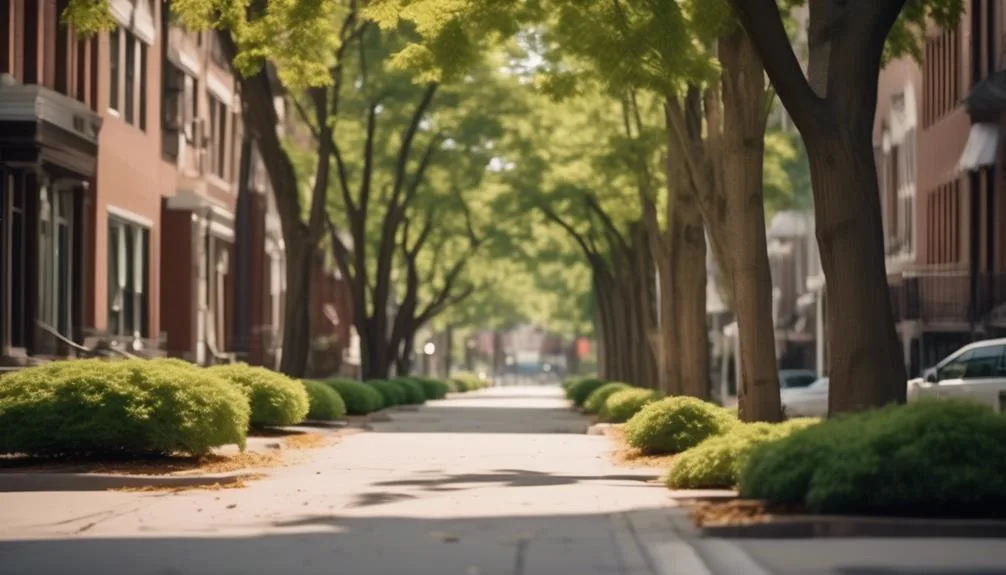Curious about those impressive hickory trees lining the streets? Wondering if they're a good fit for your community?
Let's take a closer look at whether hickory trees are suitable for planting along the streets. We'll explore their unique traits, the requirements for street planting, and the potential pros and cons.
By the end, you'll have a better understanding of whether hickory trees could be a great addition to your local streets.
Characteristics of Hickory Trees
Hickory trees are known for their tall, straight trunks, strong wood, and impressive canopy that provides ample shade. The distinctive bark of the hickory tree features deep ridges, adding to its visual appeal.
Its compound leaves turn a beautiful golden yellow in the fall, enhancing the urban landscape. The hickory tree's nuts are a valuable food source for wildlife, adding biodiversity to urban areas.
However, when considering urban landscaping challenges, it's important to note that hickory trees have deep taproots, which can potentially disrupt sidewalks and underground utilities. Additionally, their large size may pose challenges in confined urban spaces.
Despite these factors, hickory trees offer unique aesthetic and ecological benefits, making them a worthy consideration for street planting projects.
Considerations for Street Planting
When considering street planting, it's crucial to carefully assess the environmental conditions and infrastructure to ensure the successful growth and maintenance of the chosen trees. Here are three important considerations for street planting:
- Urban Environment and Tree Health:
The urban environment presents unique challenges such as pollution, compacted soil, and limited growing space. Choose tree species, like hickory, that are resilient and adaptable to urban conditions to promote tree health and longevity.
- Sidewalk Safety and Root Systems:
Select tree species with non-invasive root systems to minimize damage to sidewalks and underground utilities. Proper spacing between trees and sidewalks is also essential to prevent lifting and cracking of pavement, ensuring pedestrian safety.
- Maintenance and Care:
Consider the availability of maintenance resources such as watering, pruning, and pest control to promote healthy tree growth and minimize potential hazards.
Benefits of Using Hickory Trees
Using hickory trees in street planting offers numerous benefits. These trees are well-suited for urban environments due to their ability to withstand pollution, compacted soil, and other stressors commonly found in city settings. Their deep root systems help prevent soil erosion and contribute to the overall sustainability of the urban landscape. Hickory trees also provide ample shade, offering relief from the heat and reducing the urban heat island effect. Furthermore, their sturdy wood and strong branches make them less prone to damage from wind or storms, which can be particularly advantageous in street planting scenarios.
Potential Challenges for Street Planting
Despite their numerous benefits, street planting with hickory trees may present several potential challenges that need to be carefully considered. When considering using hickory trees for street planting, it's important to be aware of the following potential challenges:
- Root System: Hickory trees have an extensive root system that can spread widely and deeply. This can lead to issues such as uplifting sidewalks, damaging curbs, and encroaching on underground utilities.
- Infrastructure Damage: The robust and expansive root system of hickory trees can potentially cause damage to underground infrastructure such as water pipes, sewer lines, and foundations of nearby buildings.
- Maintenance: Hickory trees require regular maintenance, including pruning to prevent interference with overhead power lines and to manage their root growth, which can add to the overall cost and effort of street planting.
Careful consideration of these potential challenges is essential when deciding on the suitability of hickory trees for street planting.
Best Practices for Street Planting
Looking to ensure successful street planting with hickory trees? Let's explore the best practices for achieving optimal results.
When it comes to tree selection for urban environments, it's essential to choose species that can thrive in challenging conditions. Consider selecting hickory tree varieties known for their resilience and adaptability to urban settings. Look for species that are tolerant of pollution, compacted soil, and limited space for root growth.
Additionally, prioritize trees with strong wood and good branch structure to withstand urban stressors like wind and vehicle emissions. It's crucial to work with local arborists or horticulturists to select the most suitable hickory tree species for your specific urban environment.
Conclusion
Considering the strong wood, vibrant fall foliage, and potential challenges, hickory trees can be a suitable choice for street planting.
Careful planning and maintenance are crucial for their successful integration into urban environments.
Consulting with professionals can help determine if hickory trees align with your street planting needs, offering shade, beauty, and environmental benefits.
Mark Hoffman is a dedicated arborist and tree care specialist with over a decade of experience. His love for trees began when he visited Yosemite National Park as a teenager and was awestruck by the giant sequoias. Mark pursued his passion by studying forestry at Michigan Technological University, where he earned a Bachelor of Science degree.
Since then, he has worked tirelessly in the field of arboriculture, helping to preserve and protect trees in his community. His expertise and dedication have made him a respected leader in the industry and a valuable resource for anyone seeking advice on tree care.
